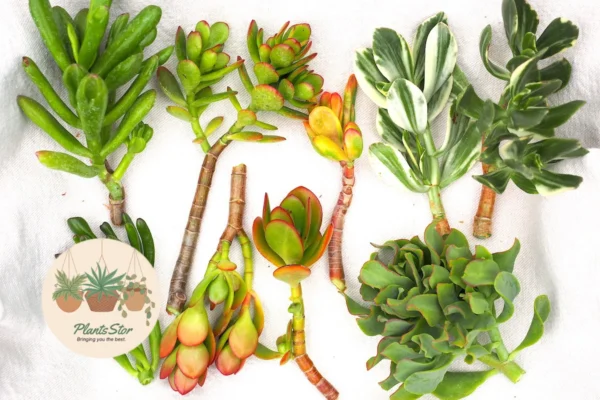Crassula Succulents Introduction:
Crassula succulents, with their diverse shapes and striking foliage, have captured the hearts of plant enthusiasts worldwide. These resilient plants, commonly known as “Jade Plants” or “Money Trees,” boast an array of varieties that thrive in various conditions. In this detailed guide, we’ll explore everything you need to know about Crassula succulents, from their origins and common varieties to essential care tips for keeping them thriving and vibrant in your home or garden.
Origins and Varieties:
Crassula is a genus of succulent plants native to Southern Africa and Madagascar. With over 200 species and countless cultivars, Crassula offers an impressive diversity of shapes, sizes, and colors. Some popular varieties include Crassula ovata (Jade Plant), Crassula argentea (Silver Jade), Crassula perforata (String of Buttons), and Crassula capitella (Red Pagoda).

Understanding Crassula Care Needs:
Crassula succulents are renowned for their adaptability and resilience, making them ideal for both indoor and outdoor cultivation. However, understanding their specific care requirements is essential for ensuring their health and longevity.
Light Requirements:
Crassula succulents thrive in bright, indirect light. Place them near a south-facing window indoors or in a location where they receive ample sunlight outdoors. While they can tolerate some direct sunlight, too much exposure may lead to sunburn, especially for variegated varieties.
Watering Routine:
One of the most critical aspects of Crassula care is proper watering. These succulents prefer a well-draining soil mix and should be watered thoroughly but infrequently. Allow the soil to dry out completely between waterings to prevent root rot. In winter, reduce watering frequency as Crassula enters a dormant phase.
Soil and Potting:
Use a well-draining soil mix specifically formulated for succulents and cacti when potting Crassula. A blend of perlite, coarse sand, and potting soil provides the ideal growing medium, allowing excess moisture to drain away from the roots. Ensure the pot has drainage holes to prevent waterlogged conditions.
Temperature and Humidity:
Crassula succulents prefer moderate temperatures ranging from 65°F to 75°F (18°C to 24°C). They can tolerate slightly cooler temperatures in winter but should be protected from frost. These plants thrive in low to moderate humidity levels, making them suitable for indoor environments.
Fertilizing:
Fertilize Crassula succulents sparingly during the growing season, typically from spring to early fall. Use a balanced, water-soluble fertilizer diluted to half strength and apply it every 4-6 weeks. Avoid over-fertilizing, as excessive nutrients can lead to leggy growth and other issues.

Propagation Techniques:
Propagation is an exciting aspect of Crassula care, allowing you to expand your collection or share plants with friends. Common propagation methods include leaf cuttings, stem cuttings, and offsets. Simply remove a healthy leaf or stem segment and allow it to callus before planting it in a well-draining soil mix.
Pest and Disease Management:
While Crassula succulents are relatively resistant to pests and diseases, they may occasionally encounter issues such as mealybugs, aphids, or fungal infections. Monitor your plants regularly for signs of pests or disease, and treat any infestations promptly using organic insecticidal soap or neem oil.
Conclusion:
Crassula succulents are a delightful addition to any indoor or outdoor space, offering beauty, versatility, and ease of care. By following the guidelines outlined in this comprehensive care guide, you can cultivate healthy and vibrant Crassula plants that bring joy and tranquility to your home or garden for years to come. Whether you’re a seasoned succulent enthusiast or a beginner looking to green up your space, Crassula succulents are sure to delight with their timeless charm and resilience.

Pingback: History and Cultural Significance of Succulents - PlantsStor